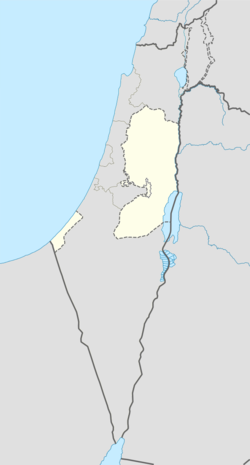Tell Ali Muntar
| Alternative name | Tell Muntar, Tell Al-Muntar |
|---|---|
| Location | Palestine |
| Coordinates | 31°29′25″N 34°28′28″E / 31.49028°N 34.47444°E |
| Area | c. 100 square metres (1,100 sq ft) |
| History | |
| Periods | Bronze Age |
Tell Ali Muntar is a tell (a mound created by accumulation of remains) about 2 kilometres (1 mi) south-east of Gaza City in Palestine. The former settlement is thought to have been occupied in the Middle Bronze Age, about the 2nd millennium BCE.[1] The remains of the settlement cover an estimated 100 square metres (1,100 sq ft). It occupied the highest point in the area around Gaza. Tell Ali Muntar was surveyed in 1998 as part of the Gaza Research Project, but it has not been excavated. The archaeologists discovered mud bricks from buildings and pottery that ranged from the Middle Bronze Age to the Ottoman period.[1] It is likely that Tell Ali Muntar was occupied at the same time as the Bronze Age settlement of Tell Gaza; archaeologists Joanna Clarke and Louise Steel suggest that settlement may have shifted from Tell Muntar to Tell Gaza.[2] UNESCO has verified that more than 100 heritage sites have been damaged as a result of the Israeli invasion of the Gaza Strip starting in 2023, including Tell Ali Muntar.[3]
Bronze Age sites near Gaza
[edit]- Al-Moghraqa
- Tell Gaza
- Tell el-Ajjul
- Tell es-Sakan
- Deir al-Balah
- Tall Rīdān
- Tall as Sanām
References
[edit]- ^ a b Clarke & Sadeq 2004, pp. 35–36.
- ^ Clarke & Steel 1999, pp. 222, 226.
- ^ Listed as "Tell Al-Muntar". UNESCO 2025
Bibliography
[edit]- Clarke, Joanna; Sadeq, Moain (2004), "Gaza Research Project: 1998 Survey of the Old City of Gaza", Levant, 36: 31–36, doi:10.1179/lev.2004.36.1.31
- Clarke, Joanna; Steel, Louise (1999), "Demographic patterns and differential settlement in the Bronze Age landscape of Palestine" (PDF), The landscape of Palestine: equivocal poetry, pp. 211–231, hdl:20.500.11889/4685
- UNESCO (28 May 2025), "Gaza Strip: Damage assessment", UNESCO, retrieved 24 June 2025



